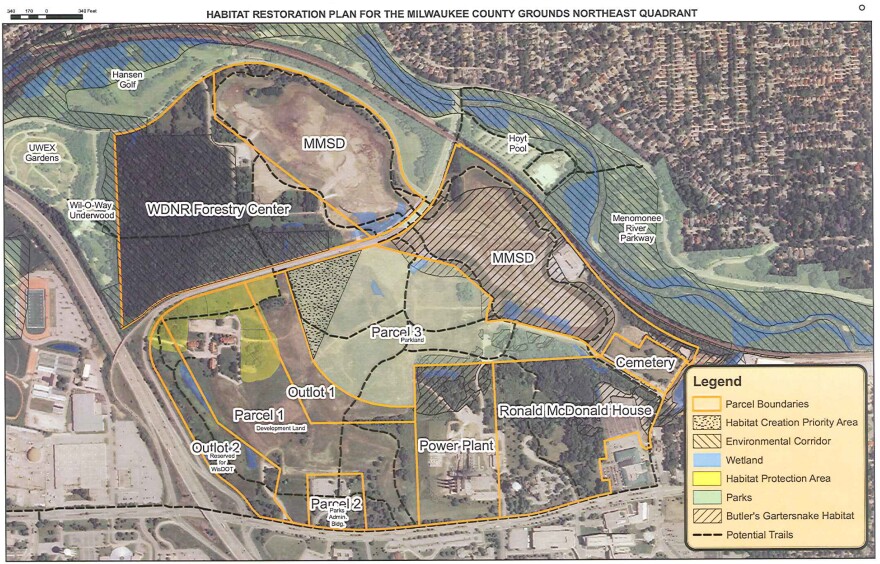Any day now, workers will begin dismantling two historic Eschweiler buildings on the former Milwaukee County Grounds in Wauwatosa.
In 2011, the UWM Real Estate Foundation purchased 88 of the 235 acre parcel to launch its Innovation Campus. Many people have remained riveted on a fraction of the land that was then sold to the Mandel Group.
Covering just over eight acres, the plot contains "The Eschweilers" - four red brick, tile-roofed buildings. Erected in 1912, they housed the Milwaukee County School of Agriculture and Domestic Economy. Designed by noted architect Alexander C. Eschweiler, the buildings are now in various stages of dilapidation.
Although vacant off and on for over a century, the buildings earned a spot on the National Register of Historic Places.

What's To Become Of The Eschweilers?
The Mandel Group is building six luxury apartment buildings that hug the western edge of the old structures.
“The smallest Eschweiler is the engineering building. We’re hoping that will be preserved as a single-family home,” Phil Aiello says. He is the company's senior development manager.
The dormitory and dairy buildings will be partially deconstructed and be transformed into walled gardens. “We will take down the exterior walls, but keep the first floor of the exterior walls. And then we’ll landscape it on the inside,” Aiello says.

The largest building will be saved. It served as the school’s administration building and will house the apartment's leasing office.
When the renovation is complete, Aiello hopes people feel the building’s history as they enter its imposing front door.
“We are keeping the chair rail, keeping the ceilings high, lighting fixtures appropriate for the time,” he says. The renovation will feature a billiard room and fitness areas for tenants. In the basement, their pets will luxuriate in their own spa.

“And on the top floor, which is really the most beautiful room of all the rooms in these old Eschweiler buildings, is the old gymnasium with vaulted ceilings and we’re going to convert it into a conference room for business meetings, weddings,” Aiello says. “The cathedral ceilings, two story height, with skylight it’s just a beautiful space...You won’t be able to replicate it anywhere."
Aiello says he would have liked nothing more than to save all four Eschweilers. “The issue we’re running into is that the cost of rehabbing them is high and the amount of actual economically usable space you get out of them is small."
Can Habitat and Development Strike A Balance?
Many people care deeply for the habitat surrounding the buildings. It is a stopover for monarch butterflies as they migrate each year to Mexico.

Green space is being preserved, including the quadrangle that stood as the original centerpiece, as well as old trees. And, native plants have been incorporated into the landscaping plan.
To accommodate the butterflies, the developer wiped several apartments off its original design so sunlight could hit a couple oak trees where monarchs have historically roosted on August and September mornings.
Barb Agnew has been watching over the butterflies since she first discovered their County Grounds migration path in 1998.

She’s not sure Mandel’s gesture will attract more monarch butterflies. “The sun will still be blocked early but it will reach them a little sooner with that gable gone. It was a compromise, and whether or not the monarchs decide to use it again sometime, we don’t know," Agnew says.
This year, Agnew estimated 800 to 900 monarchs spent time here. She says she’s watched a 90 percent drop in their numbers over the years.
Back when she started monitoring, the only structures on the grounds were a county parks' office building and The Eschweilers.
An 11-acre conservancy borders the Mandel parcel along its east, north and western edges. “It does a horseshoe and UWM is restoring this portion of it as prairie. It’s been slow, but we’re hopeful,” Agnew says.
Agnew says before Milwaukee County sold off the original 88 acres to UWM, she was among a group that drafted a habitat restoration plan. The County Board approved it in 2009.

“There are guidelines, recommendations and criteria for not only the 11-acre habitat, but for the parkland and the DOT land and the development zone. There are landscape recommendations to use native landscaping. The storm water management system is another example of where there are guidelines to put all of these pieces together in order to restore the monarch migration here,” Agnew says.
While magnificent monarchs are important attention grabbers, Agnew says the big picture is to rebuild biodiversity.
That’s difficult in an increasingly developed zone. She points to the road that bisects the grounds. Teams constructed bioswales to slow down and filter storm water along its path. “They have been planted with native plants and there were specific seed mixes used on both the basins and the side slopes, but they’ve determined much of that has failed,” Agnew says.
Agnew say compacted ground and invasive plants are partially to blame. “So they’re going to try again. I’m hoping that there is a renewed commitment from the City of Wauwatosa and Milwaukee County in making sure that all of these components get restored,” she says.
Yet she remains positive. "You’ve got highway, you’ve got buildings and everything else. But in between there’s this little tiny miracle. We’ve just got to get it to work,” Agnew says.
Not everyone is assuaged.
Cheryl Nenn with Milwaukee Riverkeeper says her organization came to life twenty years ago around efforts to stop the Milwaukee County Grounds from being parceled off and sold.
“One of the real impetuses to start the organization was to save the County Grounds. At the time, they were talking about selling the entire 235 acres, this was under (then) County Executive (Tom) Ament," Nenn says. "Sierra Club and a bunch of groups got together and said this s a very special area. It’s where two rivers come together – the Menomonee River and Underwood Creek. It was a very important habitat area for birds."

She considers the combined impacts of all of the structures popping up across the landscape environmentally unsustainable. “They’re well over the development footprint we thought was sustainable. A lot of the important key drainage areas and storm water management features we wanted to protect on the site have been destroyed. There were additional storm water management measures put in there along the new road, however there were a lot of natural features, ravines and lower lying wetland areas, that have been totally degraded."
Dennis McBride says the site was far from natural. He serves as Wauwatosa City Council president and serves on the city’s historic preservation commission.
“When they started digging for the campus, they found old steam tunnels and old foundations and foundry sand that had been dumped there... This was hardly pristine land,” he says.
Still, McBride admits the decision to zone unique public space to commercial use can be excruciating. “It is a strikingly beautiful piece of land. If you look to the east you see downtown Milwaukee, and to the north you see Mount Mary’s tower and nothing but beautiful hills and trees," he says.
He says Wauwatosa is trying to balance its resources. “We’re very cognizant of our beautiful historic neighborhoods, but also of the power of our economy. We’re trying to balance beauty and good family-supporting jobs and everything else we have out there. But it’s been a very difficult thing, charged with emotion."












